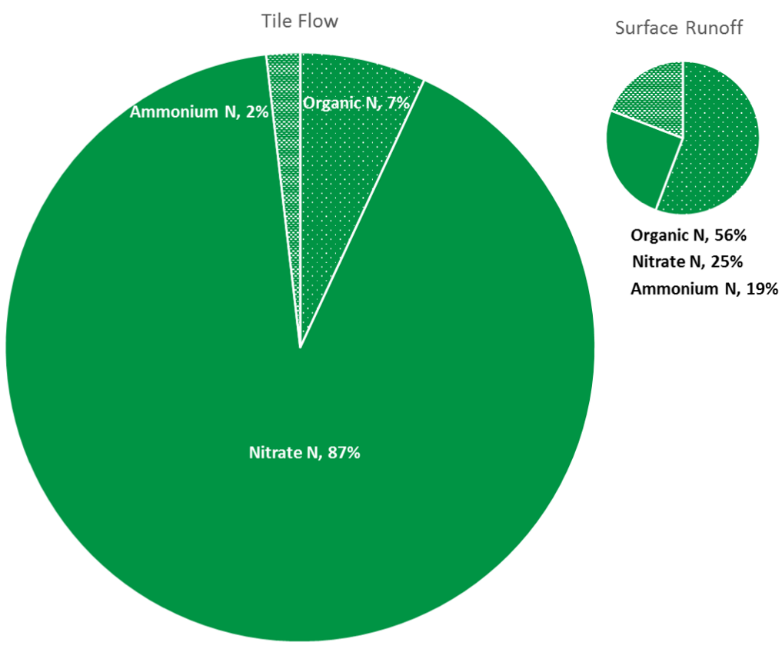Tile drainage has many benefits to agricultural production, such as improved field access and crop growth. However, tile drainage also serves as a potential pathway for nutrients to access surface water. This is especially true of nitrogen.
Nitrogen is found in many forms in the soil profile, including ammonium, nitrate, and organic nitrogen. Ammonium and nitrate are plant available forms of nitrogen. Organic nitrogen must be broken down by soil microbes in order to be plant available. The rate of this breakdown is influenced by temperature and moisture. Ammonium and organic nitrogen are relatively immobile in the soil. Nitrate, on the other hand, is mobile in the soil profile because it is a negatively charged ion and moves easily with water.
Discovery Farms programs in Minnesota and Wisconsin have collected edge-of-field water quality information from 47 fields on 24 working farms starting in 2002.
A total of 141 site years of surface runoff and 83 site years of tile flow data have been collected at the various locations. This large dataset has helped to identify how nitrogen interacts with surface runoff and tile flow.
Nitrogen is mainly transported through tile flow and in the nitrate form.
On average nitrogen losses are four times higher from tile flow compared to surface runoff. Because it is not held by the soil, nitrate can be leached out of the soil and into tile flow.
Nitrogen losses are related to the amount of tile flow.
The more tile flow, the more nitrate is moved. On average, for every inch of tile flow, 5 lb/ac of nitrogen is lost.
Minimize nitrogen losses by reducing the amount of nitrate available in the soil profile.
Improving nitrogen management and using cover crops are practices that help to reduce the amount of nitrate available in the soil profile. Applying the proper rate of nitrogen is essential to reduce nitrogen losses through tile systems. Determine proper nitrogen rates based on crop need, previous crop, soil texture, and organic matter content. Time applications as close to crop need as possible. If fall application is needed, wait until soil temperatures are below 50° F or use a nitrification inhibitor to reduce the potential for losses. Nitrate reductions from cover crops depend on the amount of growth of the cover crop. Analyze your farm system and find where cover crops could be grown effectively within fields and crop rotations.
Nitrogen losses can also be reduced by decreasing the amount of tile flow.
Controlled drainage (sometimes called managed or conservation drainage), reduced drainage intensity, and recycling drainage water are practices that can reduce the amount of tile flow from a field.
Nitrogen is primarily transported by tile flow from agricultural fields, posing challenges to water quality. However, by using management practices that reduce the concentration of nitrate in the soil profile and the amount of tile flow, the risk of excess nitrogen leaving agricultural fields can be minimized.
There are also practices that can further reduce nitrogen losses after the water leaves the field. These include bioreactors, wetlands, alternative ditch designs, and saturated buffers. For more information on these practices consult your state’s extension service. In Wisconsin, tile drainage resources can be found at: http://fyi.uwex.edu/drainage/. In Minnesota, tile drainage resources can be found at: http://www.extension.umn.edu/agriculture/water/.
This article originally appeared in the latest UW Discovery Farms newsletter. If you would like to read more from the newsletter please click here.
- Nitrogen Transport in TileDrainage Systems - August 14, 2017
